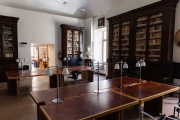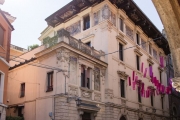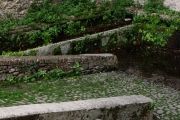In the heart of the old town, it is worth noticing Saint Antonio’s Church. The building was the settlement of a small Franciscan community, originally ruler of the complex; it was probably realized in the year 1216, when Saint Francesco (1182-1226) came to Abruzzo. At that time, the town was experiencing moments of peace as well as a great economic and building development, that is probably the reason why important churches and palaces were built: the Palazzo Vescovile, Saint Domenico’s church, Saint Domenico’s convent and Saint Francesco’s church and its convent. The church, built in 1227 and restructured in 1327, was expanded in 1377 maybe to compete with the mighty Saint Domenico’s church. The 14th century building was renovated in 1577 by brother Benedetto Liberati di Fonticello, with the support of the Spanish governor of the town Don Gaspare and, thanks to an epigraph, we have come to know about the necessity of renovating the complex which was in a state of decay. The oldest document that speaks about Saint Antonio’s church dates back to the year 1306. At that time the church was still dedicated to Saint Francesco. The document, a bull (letter) from the bishop of Teramo Rainaldo Acquaviva, reads as follows: “forty days of indulgence are granted to anyone confessed and who has received communion to visit Teramo and Campli’s Saint Francesco de’ Frati Minori’s churches, during anniversaries of their dedications and during main events of the year: as well as to anyone who would be intending to make a legacy or to contribute in any way to one or the other building”. Thanks to the historian Nicola Palma, this information has reached us and allows us to link in tight architectural and religious correlation the two churches. The first implant of Saint Francesco’s convent, had the typical Franciscan rectangular single-nave plan which ended with a small rectangular apse. The remains of paintings that are still visible today on the walls, although impossible to read, allow us to affirm that these walls were painted, like every other Franciscan church. The complex was also equipped with a cloister, a canteen and multiple dormitory cells.
The bell tower was built in 1309 by Antonio Di Florio from San Valentino and, a little later in 1327, the church was completed and expanded. Remains of the old building are the facade, the string course frame and the beautiful portal realized in Romanesque style made of white stone of Ioannella, a small village near Teramo. Similar to that of San Francesco of Campli, the portal is large and decorated with pillars and small twisted herringbone columns that are based on a high stone and brick base. The capitals, rich in foliage, create a pause as well as a pleasant continuity towards the archivolt. The large fresco, which can hardly be seen on the facade, is of the 15th century and it portrayed Saint Cristoforo.
On August 7th 1809, Gioacchino Murat, King of the two Sicilies, issued a decree in Naples suppressing still existing religious institutions. The friars of the Convent of Saint Francesco in Teramo, were forced to leave the convent and the town in a very short time. In 1811 in accordance with the Murattian deliberation, the Mayor of Teramo, Giuseppantonio Catenacci, entrusted the church to the confraternity of Saint Antonio, that had already had its headquarters there for a long time.
Between the 1700s and 1900s the church was defined inside, as it can be admired today. It was decided to keep the single-nave plan, but the vault became barrel-shaped with lunettes. Furthermore, the present nave occupies a smaller space compared to that of the 14th century and consequently the 18th century apse is not perfectly leaning against the older one. The remaining space was used as a sacristy room. Between the pillars there are four niches and three of them contain papier-mâché sculptures: The Faith (with a chalice in her hand), The Hope (with an anchor on the side), The Charity (with a young girl beside).
At present the cloister appears both on the ground floor and on the upper floor, with round arches. A slab of medieval pluteus and a slab with an elaborate rose window and numerous coats of arms, have been bricked up on the walls, in addition, there are frescoes dating back to the 16th century.
Traduzione: classe 3ALL del Liceo linguistico statale Giannina Milli



























